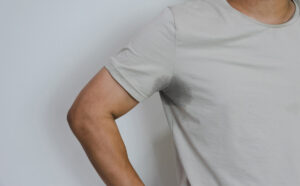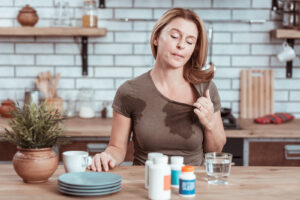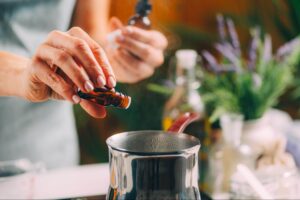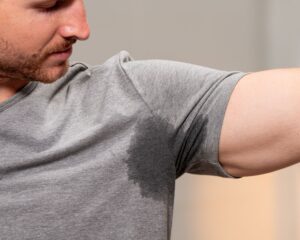Table of Contents
When sweating reaches epic proportions, you need something more than pedestrian, store-shelf antiperspirants. You need a heavy weight contender—a prescription, or prescription-“strength” antiperspirant. Here’s your guide to the best prescription-only and clinical-strength antiperspirants.
What is Prescription Antiperspirant?
As the name implies, prescription antiperspirants require a prescription and a doctor’s supervision. They cannot be purchased anywhere but a pharmacy. The concentration of active aluminum ingredient in these products is generally around 20%. Prescription options are not to be taken lightly. Misuse of prescription antiperspirants can lead to serious unwanted side effects (we’ll talk about this later).
How Does Prescription Antiperspirant Work?
All antiperspirants, regardless of brand name or strength level, use aluminum salt as the active ingredient. The most common aluminum salt compounds found in today’s antiperspirants are aluminum chloride, aluminum chlorohydrate, aluminum chloride hexahydrate and aluminum zirconium trichlorohydrex glycine.
While the effectiveness of these varies, each of these aluminum compounds works to reduce sweating in the same basic way. When they get close to water, or in this case perspiration, they soak up the moisture and thicken into a gel-like substance. By spreading aluminum chloride, or one of its cousins, on areas that sweat, the resulting reaction forms a gel-like plug that blocks the sweat glands and prevents sweat from reaching the skin’s surface. Once this happens the body’s feedback mechanism stops the flow of perspiration.
The plugs dissipate over time and the sweat glands begin to function as before. That’s when the antiperspirant must be reapplied. Depending on the strength of the antiperspirant, the reapplication time may range from several hours to several days.
Prescription Antiperspirant vs. Prescription-“Strength” Antiperspirant. Is There a Difference?
It’s not uncommon for people to confuse the two. But they are different.
Prescription-strength simply means really strong. A prescription-strength antiperspirant will have more aluminum salts or use a more potent form of aluminum. For example, aluminum chloride is a lot stronger than aluminum zirconium tetrachlorohydrex (used in antiperspirants like Dove, Old Spice, and Degree).
Most clinical- and prescription-strength antiperspirants will use aluminum chloride (usually around 12-15%).
“Prescription strength” and “clinical strength” are often both used, but they’re pretty much the same thing.
Prescription-only antiperspirants are even stronger, require a prescription, and can only be purchased at a pharmacy. They usually contain a higher concentration of aluminum chloride (20% or more) and can be more effective in extreme sweating cases. Last of all, a prescription option will most likely carry with it additional health risks and side effects (more on this below).
Prescription Antiperspirant Options:
Some of the more common prescription antiperspirant brands include:
Drysol is a popular prescription antiperspirant designed to treat hyperhidrosis and excessive sweating. Can be used on the underarms, scalp, hands, and feet. Active Ingredient: aluminum chloride hexahydrate (20%)
Xerac AC is a topical, prescription-only treatment designed for use on the underarms, palms, and feet.
Active Ingredient: aluminum chloride hexahydrate (6.25%)
Formalaz is a sweating treatment specifically designed to combat foot odor and sweat. A prescription-only option for plantar hyperhidrosis or foot sweating. Active ingredient: formaldehyde (10%)
Prescription antiperspirant is strong stuff and should only be considered after exhausting all other over-the-counter hyperhidrosis and excessive sweating treatments.
Best Prescription-Strength Antiperspirants:
Try some of these popular prescription–strength and clinical-strength antiperspirants before resorting to prescription-only solutions. Many of these products can be purchased online via Amazon or at your local drug store.
SweatBlock Clinical-Strength Antiperspirant

The original 7-day antiperspirant wipe. Formulated to reduce excessive sweating and axillary hyperhidrosis. According to users, SweatBlock keeps a person dry for an average of 6.4 days and often works when nothing else will.
Effective for: Excessive sweating and hyperhidrosis
Application: Sweat Wipe (Antiperspirant Wipe)
Active Ingredient: Aluminum Chloride (14%)
Driclor
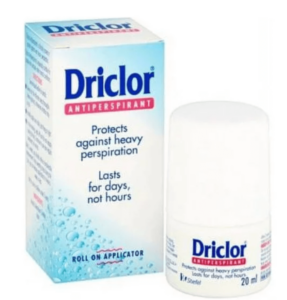
This is another over-the-counter, prescription-strength antiperspirant. It’s made in Australia and can be used for treating excessive sweating of the hands, feet, and armpits. If you’re worried about sweat stains on your shirt, you’ll want to avoid this one.
Effective for: Hands, Feet, and Armpit Sweating
Application: Roll-on
Active Ingredient: Aluminum hexahydrate (20%)
Certain Dri Clinical Strength
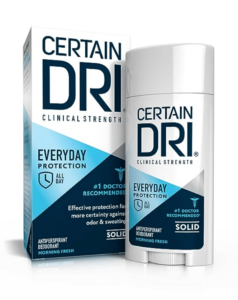
The strongest antiperspirant in the Certain Dri family. Designed for underarm use and can last up to 72 hours per application.
Effective for: Underarm Sweating/Axillary Hyperhidrosis
Application: Roll-on
Active Ingredient: Aluminum Chloride (12%)
Odaban Antiperspirant Spray
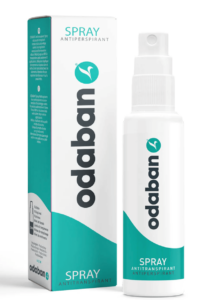
Offers 24-hour protection and may be the strongest prescription-strength antiperspirant available. It contains high concentrations of aluminum chloride which can increase effectiveness. But with increased effectiveness comes increased chance for skin irritation and burning.
Effective for: Armpits, Hands, Feet
Application: Spray
Active Ingredient: Aluminum chloride (20%)
Maxim Prescription-Strength Antiperspirant

Over-the-counter hyperhidrosis treatment designed for underarm use.
Effective for: Underarm Sweating/Axillary Hyperhidrosis
Application: Roll-on
Active Ingredient: Aluminum Chloride (15%)
If none of the above options work for you, it’s time to look at a prescription-only product.
Should I Use a Prescription-Strength Antiperspirant?
Choosing the best prescription-strength antiperspirant isn’t the same as picking out a pair of shoes or doing price comparisons on vacuum cleaners.
This is a personal question, and you and your doctor are the only ones qualified to tackle it. But here are a few things to consider as you venture down the path of prescription hyperhidrosis treatments.
How severe is your sweating? You wouldn’t be here reading this fascinating article if your sweat wasn’t somewhat excessive. But how bad is it? If it’s an occasional inconvenience, you probably don’t need a prescription-strength product. If profuse sweating has transformed you into a cave-dwelling hermit who avoids all social interaction, you’re barking up the right tree.
Which sweating treatments have you already tried? Again, if you’re reading this, you’ve probably tried A LOT. But if you’ve only experimented with Old Spice and Degree, you still have a lot of non-prescription options on the table. It’s best to exhaust all over-the-counter antiperspirant options before reaching for a prescription solution.
Have you talked to your doctor? Your doctor will be able to help you more than any blog post or article. If you’ve tried everything and nothing seems to relieve your excessive sweating, talk to your doctor about available prescription-strength antiperspirants.
Ultimately, your doctor will know which antiperspirant options are safe and can guide you through the process of finding one that works best for your body chemistry and severity of sweating.
Prescription-Strength Antiperspirant Risks & Side Effects:
The best part about prescription-strength antiperspirants is that they’re super strong. The worst part…they can come with side effects and potential health risks like:
- Allergic reactions like hives, rash, itching, chest tightness, and swelling of the face, lips, tongue, or throat.
- Severe burning, itching, redness, or swelling of treated areas.
These precautions should be observed when using prescription antiperspirants:
- Always consult a doctor before using any prescription antiperspirant.
- Tell your doctor if you are using Antabuse (disulfiram) before using.
- Do not use any other deodorant or antiperspirant (unless your doctor says otherwise).
- Avoid getting prescription antiperspirants in your eyes, nose, mouth, or on your lips.
- Do not use any antiperspirant on irritated or broken skin.
- Wait at least 24 to 48 hours when applying to shaved areas.
- Prescription antiperspirants may stain clothing and metal surfaces.
- It is not known if the use of Drysol and other prescription antiperspirants may harm an unborn baby.
Alternative Treatments to Prescription-Strength Antiperspirant:
It might be worth exploring outside the realm of prescription-strength antiperspirants. Hyperhidrosis has been around for a long time and many treatments have been developed over the years. Their effectiveness varies, but some have proven very efficient at stopping embarrassing sweat. Here are a few of them:
Clinical-Strength Antiperspirants. Over-the-counter clinical antiperspirants are stronger than your average Dove or Speed Stick, but don’t require a doctor and don’t come with as many side effects or potential health risks. We like this one (wink, wink).
QBREXZA Wipe. A prescription-only treatment for axillary hyperhidrosis, this medicated cloth is designed for underarm topical use. It contains a nerve-blocking solution that stops underarm sweat in its tracks. It can be extremely effective, but comes with a long list of unwanted side effects.
Iontophoresis is a treatment that uses electric currents in water to drive medications into the skin. This can be very effective, but also very expensive.
Botox injections. In affected areas, this can curtail sweating for months before injections must be repeated. Effective, but painful and not permanent.
Miradry. This procedure uses microwaves to nuke your sweat glands. No more sweat glands leads to no more sweat!
You might also like...

Top 10 Best Deodorants For Sweaty Armpits
Do you struggle with sweaty armpits? Has your deodorant let you down when it comes to stopping sweat and providing

Is There a Hyperhidrosis Cure? 11 Hyperhidrosis Treatment Options
If you’re one of the roughly 8 million Americans who deal with excessive sweating (also known as hyperhidrosis), this article

How to Stop Sweating So Much? 9 Tips to Beat Unwanted Sweat
If you’ve ever suffered through an awkward sweaty hug, a slippery handshake, or a sweat-soaked job interview — this article








